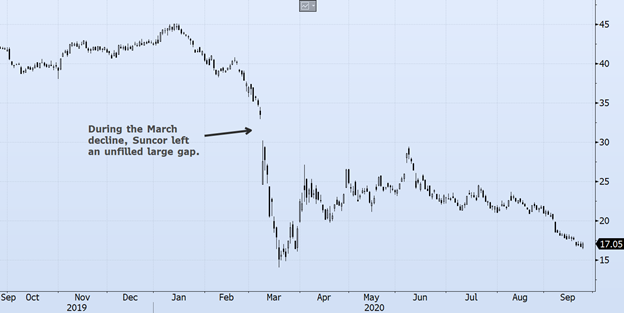Filling the Gap with a Long Call Spread

During the COVID crisis the stock market declined, but energy stocks were particularly hard hit as the price of oil plunged to levels never before seen. During the panic selling, one of Canada’s largest energy companies, Suncor Energy (ticker SU) left a gap from $33.52 to $30.19. (A down gap is where the price opens on the next day lower than the previous day’s close.)
Chart 1: Suncor Energy (symbol SU) 2019-2020

Source: Bloomberg
Many traders watch unfilled gaps closely, believing that eventually they will all be filled (meaning that the price will trade up or down to levels that it had previously gapped through).
A trader who believes in this theory could simply buy the stock and wait for the gap to fill. However, sometimes it takes a long time for the rally to develop (as evidenced by Suncor’s recent action).
Another alternative is for a trader to purchase a debit call spread (a.k.a. a bull call spread) that will deliver a profit if the gap is filled.
To implement a debit call spread, a trader buys a call option with one strike while simultaneously selling a call option with a higher strike.

Source: The Montréal Exchange – link https://www.m-x.ca/f_publications_en/strategy_bull_call_spread_en.pdf
The nice thing about this strategy is that it enables the trader to profit from a specific stock price path. In this particular case, we can use a debit call spread to express the view that Suncor Energy will trade up to $33.52 to fill the gap left during the COVID market crisis.
Suncor Energy has option series extending all the way to January 2023, but we will focus on the January 2022 series.
Here are the quotes for the options we are interested in:
| SU 1/21/22 Call 30 strike | Bid $0.53 Ask $0.76 | Mid-price $0.65 |
| SU 1/21/22 Call 34 strike | Bid $0.31 Ask $0.66 | Mid-price $0.48 |
(As of 09/25/20)
Mid-price (middle of the spread) execution equals $0.17 ($0.65 – $0.48), but it is not realistic to expect the orders to be filled at this level. However, it would not be unreasonable to expect to be filled $0.03 higher, at a debit of around $0.20.
Execution prices might look something like this:
Investor BUYS 10 SU 1/21/22 $30 Strike Calls @ $0.66
Investor SELLS 10 SU 1/21/22 $34 Strike Calls @ $0.46
The net debit to the investor is $0.20 ($0.66 minus $0.46).
If we were to buy 10 contracts of this spread, it would mean an outlay of $200. This would be the most at risk if, during the ensuing 484 days, Suncor did not fill the gap.
However, if Suncor did manage to rally back to that level, the spread would be worth $2,000, resulting in a gain of $1,800.
Debit call spreads are an interesting (and less costly) method for expressing views that specific price levels will be reached. They can be just the ticket for traders who believe that unfilled gaps are magnets that will eventually attract the stock back up to that price level.
Disclaimer:
The strategies presented in this blog are for information and training purposes only, and should not be interpreted as recommendations to buy or sell any security. As always, you should ensure that you are comfortable with the proposed scenarios and ready to assume all the risks before implementing an option strategy.
Derivatives Market Specialist
Big Picture Trading Inc.
Patrick Ceresna is the founder and Chief Derivative Market Strategist at Big Picture Trading and the co-host of both the MacroVoices and the Market Huddle podcasts. Patrick is a Chartered Market Technician, Derivative Market Specialist and Canadian Investment Manager by designation. In addition to his role at Big Picture Trading, Patrick is an instructor on derivatives for the TMX Montreal Exchange, educating investors and investment professionals across Canada about the many valuable uses of options in their investment portfolios.. Patrick specializes in analyzing the global macro market conditions and translating them into actionable investment and trading opportunities. With his specialization in technical analysis, he bridges important macro themes to produce actionable trade ideas. With his expertise in options trading, he seeks to create asymmetric opportunities that leverage returns, while managing/defining risk and or generating consistent enhanced income. Patrick has designed and actively teaches Big Picture Trading's Technical, Options, Trading and Macro Masters Programs while providing the content for the members in regards to daily live market analytic webinars, alert services and model portfolios.
The information provided on this website, including financial and economic data, quotes and any analysis or interpretation thereof, is provided solely for information purposes and shall not be construed in any jurisdiction as providing any advice or recommendation with respect to the purchase or sale of any derivative instrument, underlying security or any other financial instrument or as providing legal, accounting, tax, financial or investment advice. Bourse de Montréal Inc. recommends that you consult your own advisors in accordance with your needs before making decision to take into account your particular investment objectives, financial situation and individual needs.
All references on this website to specifications, rules and obligations concerning a product are subject to the rules, policies and procedures of Bourse de Montréal Inc. and its clearinghouse, the Canadian Derivatives Clearing Corporation, which prevail over the content of this website. Although care has been taken in the preparation of the documents published on this website, Bourse de Montréal Inc. and/or its affiliates do not guarantee the accuracy or completeness of the information published on this website and reserve the right to amend or review, at any time and without prior notice, the content of these documents. Neither Bourse de Montréal Inc. nor any of its affiliates, directors, officers, employees or agents shall be liable for any damages, losses or costs incurred as a result of any errors or omissions on this website or of the use of or reliance upon any information appearing on this website.
BAX®, CADC®, CGB®, CGF®, CGZ®, LGB®, MX®, OBX®, OGB®, OIS-MX®, ONX®, SCF®, SXA®, SXB®, SXF®, SXH®, SXM®, SXO®, SXY®, and USX® are registered trademarks of the Bourse. OBW™, OBY™, OBZ™, SXK™, SXJ™, SXU™, SXV™, Montréal Exchange and the Montréal Exchange logo are trademarks of the Bourse. All other trademarks used are the property of their respective owners.
© 2024 Bourse de Montréal Inc. All Rights Reserved.
